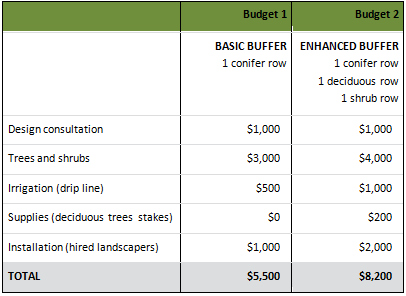Planning and installing vegetative buffers
The following topics provide information on planning, installing and maintaining vegetative buffers.
Planning for vegetative buffers
You can plan and install your own vegetative buffers, however it is strongly recommended that you consult a trained professional to help you. There is no one-size-fits-all. Consulting a trained professional will help ensure:
- Planting is right for your site
- Help determine what planting options are available to provide maximum benefits
- Ensure the right trees are selected
- Keeps the process cost-effective
Best time to plant
The best time to plant trees depends on regional climate. Generally the late fall to early spring is best, when temperatures are cool, the soil is moist and the ground is not frozen. On the South Coast of B.C. any time from late October to March is optimal as long as the ground is not frozen. Consult a local nursery professional to determine the optimal planting window for your region.
The recommended planting window is not only optimal for tree health but also is the time of year when you will have the widest selection of trees available to you for the best price. Having a vegetative buffer plan ready to go in the summer months will leave plenty of time to put in orders with local nurseries before the fall or early spring.
Costs
Cost depends on the size of your buffer and quantity and stock size of trees and shrubs required. In general, the longer your vegetative buffer and greater the number of rows, the more money it will cost for the plant material, irrigation, and installation. Prices will vary depending on the size of the plant stock. Larger, older trees cost more but will provide a benefit sooner.
Tree shape also influences cost. If you choose narrower trees that must be spaced closer together, you will need a greater quantity in comparison to wider trees that can be planted further apart. Site preparation can also add to the cost (for example, if soil is needed or a berm is constructed to raise the height of the buffer).
Below are two hypothetical budgets for a poultry operation with a 300 foot (90 meter) long barn.
- Budget 1 is a lower cost, basic option with one row of coniferous trees for dust and odour mitigation
- Budget 2 offers an enhanced buffer with a conifer and shrub row as well as a deciduous tree row to provide summer shade
An imaginary farm budget scenario with basic and enhanced buffer options:

Note: These are hypothetical numbers. True industry costs have to be investigated for each site. Other site specific costs may arise which would increase the overall budget.
Installing and maintaining vegetative buffers
Installing
Trained professionals are also available for installation. They can assist to:
- Facilitate ordering large quantities of trees from local wholesale nurseries
- Ensure planting is done to professional standards
- Set you up for future success by installing irrigation and advising on weed control strategies
View case studies that showcase several types of farms with recently installed tree buffers.
Maintenance
A vegetative buffer is a living organism that will need some tending to survive and thrive. For the first two to three years after planting, trees will need watering during summer dry spells. An irrigation system can provide this service with minimal effort. Competing vegetation (weeds) will require removal during this period to allow the trees to successfully establish. Trees may require staking as temporary support to withstand heavy winds in their early years.
From then on, it is important to monitor tree health and make sure changes to farm operations are not negatively affecting trees. At the first sign of stress it is critical to address the problem to avoid losses to your investment. Semi-annual pruning may also be beneficial depending on the tree species.
This beneficial management practice aims to set you up for success with a healthy buffer that will require minimal maintenance. The beneficial management practice has a care and maintenance section to give you a general sense of common maintenance activities. It is best to consult a trained professional to assist you in creating a maintenance plan specific to your vegetative buffer and farm situation.
Financial programs are available for agricultural producers. View all B.C. agriculture programs.
